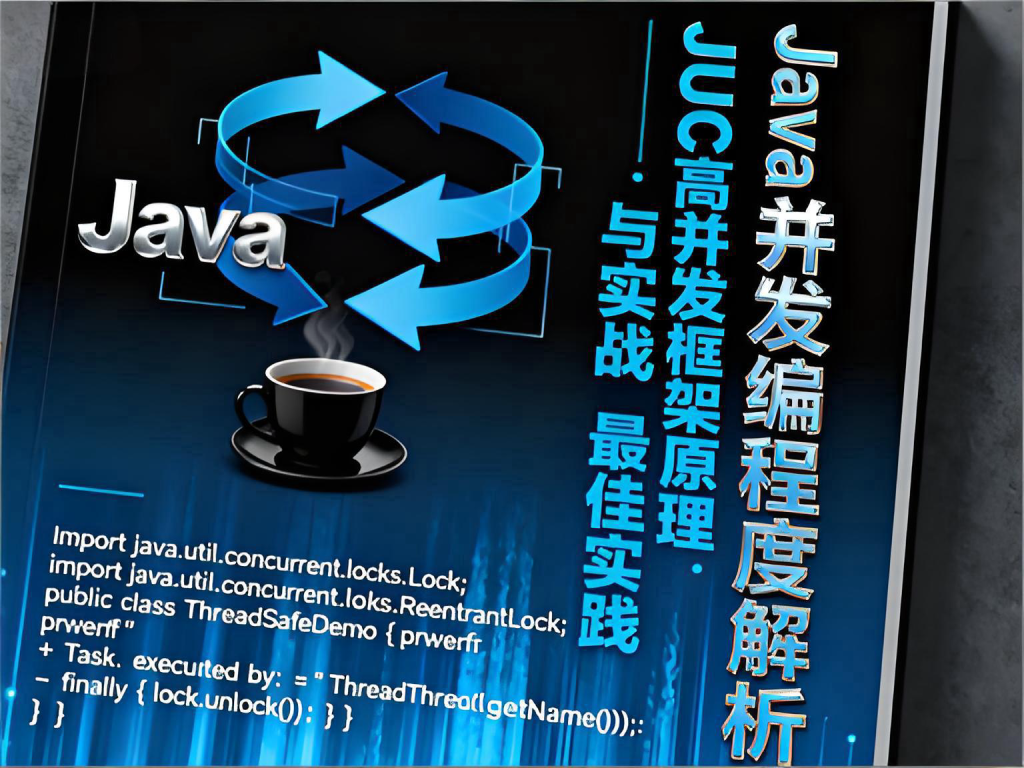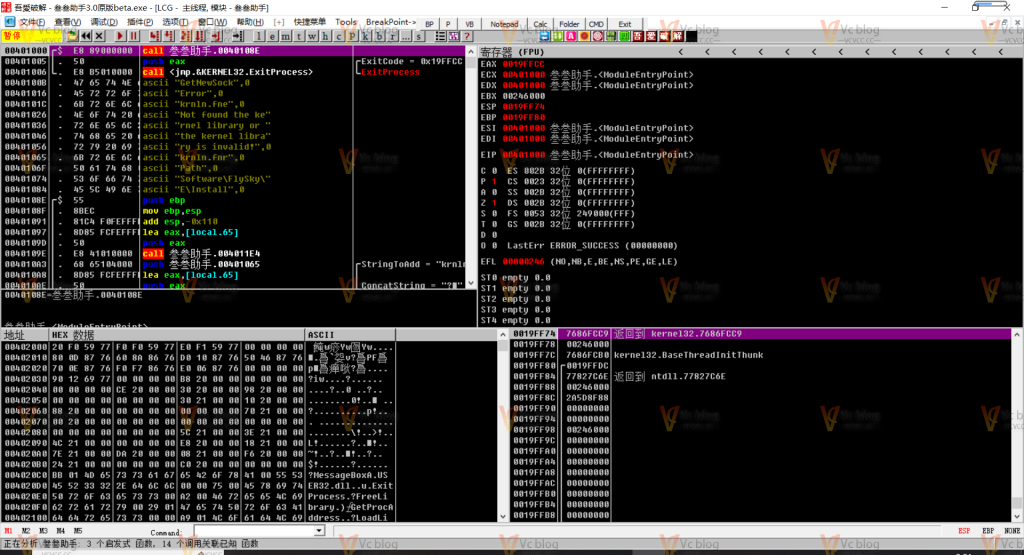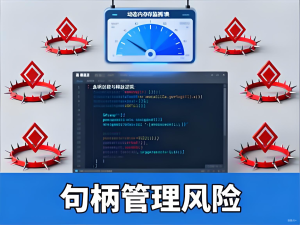Java并发编程是现代高并发系统设计的核心技术,JUC(java.util.concurrent)框架提供了完整的并发解决方案。本文从底层实现原理出发,深入分析线程池工作机制、锁优化策略、并发集合数据结构,并结合实际业务场景提供完整的性能优化方案和最佳实践。
![图片[1]-Java并发编程深度解析:JUC高并发框架原理与实战最佳实践](https://blogimg.vcvcc.cc/2025/11/20251114112719536-1024x768.png?imageView2/0/format/webp/q/75)
一、JUC框架架构深度剖析
1. JUC包层次结构与设计哲学
/**
* JUC框架核心组件分析
*/
public class JUCArchitectureAnalysis {
/**
* JUC包核心组件分类:
* 1. 原子操作类 (Atomic) - 无锁编程基础
* 2. 锁框架 (Locks) - AQS抽象队列同步器
* 3. 并发集合 (Collections) - CAS优化数据结构
* 4. 线程池 (Executor) - 线程生命周期管理
* 5. 同步工具 (Tools) - CountDownLatch/CyclicBarrier等
*/
// AQS(AbstractQueuedSynchronizer)核心原理演示
static class CustomLock extends AbstractQueuedSynchronizer {
private static final long serialVersionUID = 1L;
// 尝试获取锁
@Override
protected boolean tryAcquire(int arg) {
// CAS操作:期望0,更新为1
return compareAndSetState(0, 1);
}
// 尝试释放锁
@Override
protected boolean tryRelease(int arg) {
setState(0); // 不需要CAS,因为只有持有锁的线程能释放
return true;
}
// 是否独占模式
@Override
protected boolean isHeldExclusively() {
return getState() == 1;
}
public void lock() {
acquire(1);
}
public void unlock() {
release(1);
}
}
/**
* AQS队列状态分析工具
*/
public static void analyzeAQSState(AbstractQueuedSynchronizer aqs) {
System.out.println("AQS状态分析:");
System.out.println("State: " + aqs.getState());
// 通过反射获取内部队列信息(实际生产环境慎用)
try {
Field headField = AbstractQueuedSynchronizer.class.getDeclaredField("head");
Field tailField = AbstractQueuedSynchronizer.class.getDeclaredField("tail");
headField.setAccessible(true);
tailField.setAccessible(true);
Object head = headField.get(aqs);
Object tail = tailField.get(aqs);
System.out.println("等待队列头: " + head);
System.out.println("等待队列尾: " + tail);
} catch (Exception e) {
// 忽略反射异常
}
}
}
/**
* 内存屏障与可见性验证
*/
public class MemoryBarrierDemo {
private volatile boolean flag = false;
private int nonVolatileValue = 0;
public void writer() {
nonVolatileValue = 42; // 普通写
flag = true; // volatile写,建立happens-before关系
}
public void reader() {
if (flag) { // volatile读,能看到之前的所有写操作
// 由于happens-before,这里一定能看到nonVolatileValue = 42
System.out.println("Non-volatile value: " + nonVolatileValue);
}
}
/**
* 验证指令重排序
*/
private static int x = 0, y = 0;
private static int a = 0, b = 0;
public static void testReorder() throws InterruptedException {
for (int i = 0; i < 100000; i++) {
x = y = a = b = 0;
Thread t1 = new Thread(() -> {
a = 1; // 操作1
x = b; // 操作2
});
Thread t2 = new Thread(() -> {
b = 1; // 操作3
y = a; // 操作4
});
t1.start();
t2.start();
t1.join();
t2.join();
// 如果发生指令重排序,可能出现 x=0,y=0
if (x == 0 && y == 0) {
System.out.println("检测到指令重排序! i=" + i);
break;
}
}
}
}二、线程池深度优化与监控
1. 线程池核心参数动态调优
/**
* 动态可配置线程池
*/
public class DynamicThreadPoolExecutor extends ThreadPoolExecutor {
private final String poolName;
private final ThreadPoolMetrics metrics;
// 监控指标
private final AtomicLong totalTasks = new AtomicLong();
private final AtomicLong completedTasks = new AtomicLong();
private final AtomicLong rejectedTasks = new AtomicLong();
private final LongAdder activeThreads = new LongAdder();
private final Histogram taskDurationHistogram;
public DynamicThreadPoolExecutor(String poolName,
int corePoolSize,
int maximumPoolSize,
long keepAliveTime,
TimeUnit unit,
BlockingQueue<Runnable> workQueue,
ThreadFactory threadFactory,
RejectedExecutionHandler handler) {
super(corePoolSize, maximumPoolSize, keepAliveTime, unit, workQueue, threadFactory, handler);
this.poolName = poolName;
this.metrics = new ThreadPoolMetrics(poolName);
this.taskDurationHistogram = new Histogram(TimeUnit.SECONDS.toMillis(10));
}
@Override
public void execute(Runnable command) {
totalTasks.incrementAndGet();
long startTime = System.currentTimeMillis();
super.execute(() -> {
activeThreads.increment();
try {
command.run();
completedTasks.incrementAndGet();
} finally {
activeThreads.decrement();
long duration = System.currentTimeMillis() - startTime;
taskDurationHistogram.recordValue(duration);
metrics.recordTaskDuration(duration);
}
});
}
@Override
protected void beforeExecute(Thread t, Runnable r) {
super.beforeExecute(t, r);
metrics.recordThreadStart();
}
@Override
protected void afterExecute(Runnable r, Throwable t) {
super.afterExecute(r, t);
metrics.recordThreadFinish();
if (t != null) {
metrics.recordTaskError();
}
}
@Override
protected void terminated() {
super.terminated();
metrics.recordPoolShutdown();
}
/**
* 动态调整核心参数
*/
public void dynamicAdjust(int newCorePoolSize, int newMaximumPoolSize) {
if (newCorePoolSize > 0) {
setCorePoolSize(newCorePoolSize);
}
if (newMaximumPoolSize >= newCorePoolSize) {
setMaximumPoolSize(newMaximumPoolSize);
}
}
/**
* 获取线程池状态快照
*/
public ThreadPoolSnapshot getSnapshot() {
return new ThreadPoolSnapshot(
poolName,
getPoolSize(),
getActiveCount(),
getCorePoolSize(),
getMaximumPoolSize(),
getQueue().size(),
getQueue().remainingCapacity(),
getCompletedTaskCount(),
totalTasks.get(),
rejectedTasks.get(),
getLargestPoolSize(),
getTaskCount()
);
}
/**
* 基于负载的动态调整策略
*/
public void autoScaleBasedOnLoad() {
ThreadPoolSnapshot snapshot = getSnapshot();
double loadFactor = calculateLoadFactor(snapshot);
if (loadFactor > 0.8) {
// 高负载,扩容
int newCoreSize = Math.min(
getCorePoolSize() * 2,
getMaximumPoolSize()
);
dynamicAdjust(newCoreSize, getMaximumPoolSize());
metrics.recordAutoScaleUp();
} else if (loadFactor < 0.3 && getCorePoolSize() > 1) {
// 低负载,缩容
int newCoreSize = Math.max(1, getCorePoolSize() / 2);
dynamicAdjust(newCoreSize, getMaximumPoolSize());
metrics.recordAutoScaleDown();
}
}
private double calculateLoadFactor(ThreadPoolSnapshot snapshot) {
int totalCapacity = snapshot.getCorePoolSize() + snapshot.getQueueRemainingCapacity();
if (totalCapacity == 0) return 1.0;
int currentLoad = snapshot.getActiveCount() + snapshot.getQueueSize();
return (double) currentLoad / totalCapacity;
}
}
/**
* 线程池状态快照
*/
class ThreadPoolSnapshot {
private final String poolName;
private final int poolSize;
private final int activeCount;
private final int corePoolSize;
private final int maximumPoolSize;
private final int queueSize;
private final int queueRemainingCapacity;
private final long completedTaskCount;
private final long totalTasks;
private final long rejectedTasks;
private final int largestPoolSize;
private final long taskCount;
// 构造函数、getter方法...
@Override
public String toString() {
return String.format(
"ThreadPool[%s]: active=%d, pool=%d, queue=%d/%d, completed=%d, rejected=%d",
poolName, activeCount, poolSize, queueSize,
queueSize + queueRemainingCapacity, completedTaskCount, rejectedTasks
);
}
}
/**
* 线程池监控指标收集
*/
class ThreadPoolMetrics {
private final String poolName;
private final Meter taskRate;
private final Timer taskDuration;
private final Counter activeThreads;
private final Counter rejectedTasks;
private final Counter autoScaleEvents;
public ThreadPoolMetrics(String poolName) {
this.poolName = poolName;
// 初始化监控指标(这里使用简化的实现)
this.taskRate = new Meter();
this.taskDuration = new Timer();
this.activeThreads = new Counter();
this.rejectedTasks = new Counter();
this.autoScaleEvents = new Counter();
}
public void recordTaskDuration(long durationMs) {
taskDuration.record(durationMs, TimeUnit.MILLISECONDS);
}
public void recordThreadStart() {
activeThreads.increment();
}
public void recordThreadFinish() {
activeThreads.decrement();
}
public void recordTaskError() {
// 错误统计
}
public void recordPoolShutdown() {
// 关闭事件记录
}
public void recordAutoScaleUp() {
autoScaleEvents.increment();
}
public void recordAutoScaleDown() {
autoScaleEvents.increment();
}
}2. 线程池任务执行链路追踪
/**
* 支持链路追踪的线程池
*/
public class TraceableThreadPoolExecutor extends ThreadPoolExecutor {
private static final ThreadLocal<Map<String, String>> traceContext = new ThreadLocal<>();
public TraceableThreadPoolExecutor(int corePoolSize, int maximumPoolSize,
long keepAliveTime, TimeUnit unit,
BlockingQueue<Runnable> workQueue,
ThreadFactory threadFactory,
RejectedExecutionHandler handler) {
super(corePoolSize, maximumPoolSize, keepAliveTime, unit, workQueue, threadFactory, handler);
}
/**
* 包装Runnable,传递trace上下文
*/
@Override
public void execute(Runnable command) {
// 捕获调用线程的trace上下文
Map<String, String> currentTraceContext = captureTraceContext();
Runnable tracedTask = () -> {
try {
// 在任务执行线程中设置trace上下文
if (currentTraceContext != null) {
traceContext.set(currentTraceContext);
}
command.run();
} finally {
// 清理threadlocal
traceContext.remove();
}
};
super.execute(tracedTask);
}
/**
* 支持Callable的提交方法
*/
@Override
public <T> Future<T> submit(Callable<T> task) {
Map<String, String> currentTraceContext = captureTraceContext();
Callable<T> tracedTask = () -> {
try {
if (currentTraceContext != null) {
traceContext.set(currentTraceContext);
}
return task.call();
} finally {
traceContext.remove();
}
};
return super.submit(tracedTask);
}
private Map<String, String> captureTraceContext() {
// 从当前线程捕获trace信息
Map<String, String> context = new HashMap<>();
context.put("traceId", generateTraceId());
context.put("spanId", generateSpanId());
context.put("thread", Thread.currentThread().getName());
context.put("timestamp", String.valueOf(System.currentTimeMillis()));
return context;
}
private String generateTraceId() {
return UUID.randomUUID().toString().replace("-", "").substring(0, 16);
}
private String generateSpanId() {
return Long.toHexString(ThreadLocalRandom.current().nextLong());
}
/**
* 获取当前任务的trace上下文
*/
public static Map<String, String> getCurrentTraceContext() {
return traceContext.get();
}
/**
* 创建带trace信息的任务包装器
*/
public static Runnable wrapWithTrace(Runnable task, Map<String, String> context) {
return () -> {
try {
traceContext.set(context);
task.run();
} finally {
traceContext.remove();
}
};
}
}
/**
* 线程池任务执行监控
*/
class ThreadPoolTaskMonitor {
private final Map<String, TaskExecutionStats> taskStats = new ConcurrentHashMap<>();
private final ScheduledExecutorService monitorExecutor =
Executors.newSingleThreadScheduledExecutor();
public void startMonitoring(ThreadPoolExecutor executor, String poolName) {
monitorExecutor.scheduleAtFixedRate(() -> {
ThreadPoolSnapshot snapshot = ((DynamicThreadPoolExecutor) executor).getSnapshot();
recordStats(poolName, snapshot);
// 检查异常情况
checkForAnomalies(snapshot);
}, 0, 5, TimeUnit.SECONDS);
}
private void recordStats(String poolName, ThreadPoolSnapshot snapshot) {
TaskExecutionStats stats = taskStats.computeIfAbsent(poolName,
k -> new TaskExecutionStats());
stats.recordSnapshot(snapshot);
}
private void checkForAnomalies(ThreadPoolSnapshot snapshot) {
// 检查线程池死锁
if (snapshot.getActiveCount() == snapshot.getPoolSize() &&
snapshot.getQueueSize() > 0 &&
snapshot.getCompletedTaskCount() == 0) {
System.err.println("可能的线程池死锁: " + snapshot.getPoolName());
}
// 检查任务拒绝率
double rejectionRate = (double) snapshot.getRejectedTasks() /
Math.max(1, snapshot.getTotalTasks());
if (rejectionRate > 0.1) {
System.err.println("高任务拒绝率: " + rejectionRate);
}
}
public void generateReport() {
System.out.println("=== 线程池监控报告 ===");
taskStats.forEach((poolName, stats) -> {
System.out.println("线程池: " + poolName);
System.out.println(stats.generateReport());
System.out.println("-------------------");
});
}
}
class TaskExecutionStats {
private final List<ThreadPoolSnapshot> snapshots = new ArrayList<>();
private long maxQueueSize = 0;
private long maxActiveThreads = 0;
public void recordSnapshot(ThreadPoolSnapshot snapshot) {
snapshots.add(snapshot);
maxQueueSize = Math.max(maxQueueSize, snapshot.getQueueSize());
maxActiveThreads = Math.max(maxActiveThreads, snapshot.getActiveCount());
}
public String generateReport() {
if (snapshots.isEmpty()) return "无数据";
ThreadPoolSnapshot latest = snapshots.get(snapshots.size() - 1);
return String.format(
"最大队列深度: %d, 最大活跃线程: %d, 总完成任务: %d, 拒绝任务: %d",
maxQueueSize, maxActiveThreads, latest.getCompletedTaskCount(),
latest.getRejectedTasks()
);
}
}三、锁机制性能优化与死锁预防
1. 锁粒度优化与分段锁实战
/**
* 高性能分段锁Map实现
*/
public class SegmentLockMap<K, V> {
// 分段数量 - 通常为2的幂次方
private static final int DEFAULT_CONCURRENCY_LEVEL = 16;
private final int segmentMask;
private final int segmentShift;
private final Segment<K, V>[] segments;
/**
* 分段内部类
*/
static final class Segment<K, V> extends ReentrantLock {
private volatile HashEntry<K, V>[] table;
private volatile int count;
private transient int modCount;
// 分段内的哈希表操作
V get(K key, int hash) {
if (count != 0) { // 读volatile变量
HashEntry<K, V> e = getFirst(hash);
while (e != null) {
if (e.hash == hash && key.equals(e.key)) {
V v = e.value;
if (v != null) { // 检查值是否被清除
return v;
}
// 值被清除,重新读取
return readValueUnderLock(e);
}
e = e.next;
}
}
return null;
}
V put(K key, int hash, V value, boolean onlyIfAbsent) {
lock();
try {
// 分段内的put实现...
return null;
} finally {
unlock();
}
}
private HashEntry<K, V> getFirst(int hash) {
HashEntry<K, V>[] tab = table;
return tab[hash & (tab.length - 1)];
}
private V readValueUnderLock(HashEntry<K, V> e) {
lock();
try {
return e.value;
} finally {
unlock();
}
}
}
/**
* 哈希条目
*/
static final class HashEntry<K, V> {
final K key;
final int hash;
volatile V value;
final HashEntry<K, V> next;
HashEntry(K key, int hash, HashEntry<K, V> next, V value) {
this.key = key;
this.hash = hash;
this.next = next;
this.value = value;
}
}
public SegmentLockMap(int initialCapacity, float loadFactor, int concurrencyLevel) {
// 确保分段数量为2的幂次方
int sshift = 0;
int ssize = 1;
while (ssize < concurrencyLevel) {
++sshift;
ssize <<= 1;
}
segmentShift = 32 - sshift;
segmentMask = ssize - 1;
// 创建分段数组
this.segments = new Segment[ssize];
for (int i = 0; i < this.segments.length; ++i) {
this.segments[i] = new Segment<>();
}
}
/**
* 根据key的hash选择分段
*/
private Segment<K, V> segmentFor(int hash) {
return segments[(hash >>> segmentShift) & segmentMask];
}
public V get(K key) {
int hash = hash(key.hashCode());
return segmentFor(hash).get(key, hash);
}
public V put(K key, V value) {
int hash = hash(key.hashCode());
return segmentFor(hash).put(key, hash, value, false);
}
/**
* 哈希函数 - 减少碰撞
*/
private static int hash(int h) {
h ^= (h >>> 20) ^ (h >>> 12);
return h ^ (h >>> 7) ^ (h >>> 4);
}
}
/**
* 读写锁优化 - 锁降级示例
*/
public class ReadWriteLockCache<K, V> {
private final Map<K, V> cache = new HashMap<>();
private final ReadWriteLock rwLock = new ReentrantReadWriteLock();
private final Lock readLock = rwLock.readLock();
private final Lock writeLock = rwLock.writeLock();
/**
* 锁降级:写锁 -> 读锁
* 保证数据一致性同时提高读性能
*/
public V getWithLockDowngrade(K key) {
V value;
// 首先尝试读锁
readLock.lock();
try {
value = cache.get(key);
if (value != null) {
return value;
}
} finally {
readLock.unlock();
}
// 缓存未命中,获取写锁
writeLock.lock();
try {
// 双重检查,防止其他线程已经加载
value = cache.get(key);
if (value == null) {
// 模拟从数据库加载
value = loadFromDatabase(key);
cache.put(key, value);
}
// 锁降级:在写锁内部获取读锁
readLock.lock();
} finally {
writeLock.unlock(); // 释放写锁,但仍然持有读锁
}
try {
// 这里仍然持有读锁,可以安全地使用value
processValue(value);
return value;
} finally {
readLock.unlock();
}
}
/**
* 批量更新优化 - 减少锁粒度
*/
public void batchUpdate(Map<K, V> updates) {
if (updates.isEmpty()) return;
// 对更新进行分组,减少锁竞争
Map<Object, Map<K, V>> segmentedUpdates = segmentUpdates(updates);
for (Map<K, V> segment : segmentedUpdates.values()) {
writeLock.lock();
try {
cache.putAll(segment);
} finally {
writeLock.unlock();
}
}
}
private Map<Object, Map<K, V>> segmentUpdates(Map<K, V> updates) {
// 简化的分段逻辑,实际可根据key的hash进行分段
Map<Object, Map<K, V>> segments = new HashMap<>();
Map<K, V> segment = new HashMap<>(updates);
segments.put("segment1", segment);
return segments;
}
private V loadFromDatabase(K key) {
// 模拟数据库加载
try {
Thread.sleep(10);
} catch (InterruptedException e) {
Thread.currentThread().interrupt();
}
return (V) ("value_" + key);
}
private void processValue(V value) {
// 处理值的逻辑
}
}2. 死锁检测与预防机制
/**
* 死锁检测与预防工具
*/
public class DeadlockDetector {
private final ScheduledExecutorService scheduler =
Executors.newSingleThreadScheduledExecutor();
private final Set<Thread> monitoredThreads = ConcurrentHashMap.newKeySet();
private final Map<Thread, LockInfo> threadLockInfo = new ConcurrentHashMap<>();
/**
* 可检测死锁的锁
*/
public static class DetectableReentrantLock extends ReentrantLock {
private final String lockName;
private final ThreadLocal<Long> lockAcquireTime = new ThreadLocal<>();
public DetectableReentrantLock(String lockName) {
this.lockName = lockName;
}
@Override
public void lock() {
long startTime = System.currentTimeMillis();
super.lock();
long acquireTime = System.currentTimeMillis() - startTime;
if (acquireTime > 1000) { // 获取锁超过1秒,记录警告
System.err.println("锁获取缓慢: " + lockName + ", 耗时: " + acquireTime + "ms");
}
lockAcquireTime.set(System.currentTimeMillis());
recordLockAcquisition();
}
@Override
public void unlock() {
Long acquireTime = lockAcquireTime.get();
if (acquireTime != null) {
long holdTime = System.currentTimeMillis() - acquireTime;
if (holdTime > 5000) { // 持有锁超过5秒,记录警告
System.err.println("锁持有时间过长: " + lockName + ", 持有: " + holdTime + "ms");
}
lockAcquireTime.remove();
}
super.unlock();
}
private void recordLockAcquisition() {
Thread currentThread = Thread.currentThread();
DeadlockDetector.getInstance().recordLockAcquire(currentThread, this);
}
}
/**
* 锁信息记录
*/
static class LockInfo {
private final Thread thread;
private final DetectableReentrantLock lock;
private final long acquireTime;
private final StackTraceElement[] stackTrace;
public LockInfo(Thread thread, DetectableReentrantLock lock) {
this.thread = thread;
this.lock = lock;
this.acquireTime = System.currentTimeMillis();
this.stackTrace = Thread.currentThread().getStackTrace();
}
}
private static final DeadlockDetector INSTANCE = new DeadlockDetector();
private DeadlockDetector() {
// 启动死锁检测
scheduler.scheduleAtFixedRate(this::detectDeadlocks, 5, 5, TimeUnit.SECONDS);
}
public static DeadlockDetector getInstance() {
return INSTANCE;
}
public void recordLockAcquire(Thread thread, DetectableReentrantLock lock) {
threadLockInfo.put(thread, new LockInfo(thread, lock));
monitoredThreads.add(thread);
}
public void recordLockRelease(Thread thread) {
threadLockInfo.remove(thread);
}
/**
* 死锁检测算法
*/
private void detectDeadlocks() {
Map<Thread, LockInfo> currentLocks = new HashMap<>(threadLockInfo);
// 检查锁等待关系
for (LockInfo info : currentLocks.values()) {
if (isThreadBlocked(info.thread)) {
analyzePotentialDeadlock(info.thread, currentLocks);
}
}
// 检查锁持有时间
checkLockHoldTime(currentLocks);
}
private boolean isThreadBlocked(Thread thread) {
return thread.getState() == Thread.State.BLOCKED;
}
private void analyzePotentialDeadlock(Thread blockedThread, Map<Thread, LockInfo> locks) {
// 构建锁等待图
Map<DetectableReentrantLock, Thread> lockOwners = new HashMap<>();
Map<Thread, DetectableReentrantLock> waitingLocks = new HashMap<>();
for (LockInfo info : locks.values()) {
lockOwners.put(info.lock, info.thread);
}
// 查找等待关系
for (LockInfo info : locks.values()) {
if (info.thread.getState() == Thread.State.BLOCKED) {
// 这里简化处理,实际需要获取线程等待的锁
waitingLocks.put(info.thread, info.lock);
}
}
// 检测循环等待
if (hasCycle(waitingLocks, lockOwners)) {
System.err.println("检测到可能的死锁!");
dumpDeadlockInfo(waitingLocks, lockOwners);
}
}
private boolean hasCycle(Map<Thread, DetectableReentrantLock> waitingLocks,
Map<DetectableReentrantLock, Thread> lockOwners) {
// 简化的环检测算法
for (Map.Entry<Thread, DetectableReentrantLock> entry : waitingLocks.entrySet()) {
Thread waiter = entry.getKey();
DetectableReentrantLock waitingLock = entry.getValue();
Thread owner = lockOwners.get(waitingLock);
if (owner != null && waitingLocks.containsKey(owner)) {
DetectableReentrantLock ownerWaitingLock = waitingLocks.get(owner);
if (lockOwners.get(ownerWaitingLock) == waiter) {
return true; // 发现循环等待
}
}
}
return false;
}
private void checkLockHoldTime(Map<Thread, LockInfo> locks) {
long currentTime = System.currentTimeMillis();
for (LockInfo info : locks.values()) {
long holdTime = currentTime - info.acquireTime;
if (holdTime > 30000) { // 30秒
System.err.println("锁持有时间超长警告:");
System.err.println("线程: " + info.thread.getName());
System.err.println("锁: " + info.lock.lockName);
System.err.println("持有时间: " + holdTime + "ms");
// 打印堆栈信息
for (StackTraceElement element : info.stackTrace) {
System.err.println(" " + element);
}
}
}
}
private void dumpDeadlockInfo(Map<Thread, DetectableReentrantLock> waitingLocks,
Map<DetectableReentrantLock, Thread> lockOwners) {
System.err.println("=== 死锁信息 ===");
for (Map.Entry<Thread, DetectableReentrantLock> entry : waitingLocks.entrySet()) {
System.err.println("线程 " + entry.getKey().getName() +
" 等待锁 " + entry.getValue().lockName);
}
}
}
/**
* 锁顺序化 - 死锁预防
*/
public class LockOrdering {
/**
* 基于资源ID的锁顺序化
*/
public static class OrderedLockManager {
private final ConcurrentHashMap<Object, Object> locks = new ConcurrentHashMap<>();
public void withOrderedLocks(Object resource1, Object resource2, Runnable task) {
// 确保锁的顺序一致性
Object firstLock, secondLock;
int hash1 = System.identityHashCode(resource1);
int hash2 = System.identityHashCode(resource2);
if (hash1 < hash2) {
firstLock = resource1;
secondLock = resource2;
} else if (hash1 > hash2) {
firstLock = resource2;
secondLock = resource1;
} else {
// hash冲突,使用tie-breaker
firstLock = getTieLock(resource1, resource2);
secondLock = (firstLock == resource1) ? resource2 : resource1;
}
synchronized (firstLock) {
synchronized (secondLock) {
task.run();
}
}
}
private Object getTieLock(Object resource1, Object resource2) {
// 使用其他机制打破平局
return locks.computeIfAbsent(resource1, k -> new Object());
}
}
/**
* 尝试锁 - 避免死锁
*/
public static class TryLockManager {
private final Lock lock1 = new ReentrantLock();
private final Lock lock2 = new ReentrantLock();
public boolean tryBothLocks(long timeout, TimeUnit unit) throws InterruptedException {
long stopTime = System.nanoTime() + unit.toNanos(timeout);
while (true) {
if (lock1.tryLock()) {
try {
if (lock2.tryLock(100, TimeUnit.MILLISECONDS)) {
return true; // 成功获取两个锁
}
} finally {
lock1.unlock();
}
}
if (System.nanoTime() > stopTime) {
return false;
}
// 随机退避
Thread.sleep(ThreadLocalRandom.current().nextInt(50, 100));
}
}
}
}四、并发集合底层原理与性能对比
1. ConcurrentHashMap源码级分析
/**
* ConcurrentHashMap实现原理分析
*/
public class ConcurrentHashMapAnalysis {
/**
* JDK 8 ConcurrentHashMap核心改进:
* 1. 取消分段锁,使用Node数组 + synchronized + CAS
* 2. 树化优化:链表转红黑树
* 3. 扩容协助机制
*/
// 模拟ConcurrentHashMap的putVal方法核心逻辑
public static class ConcurrentHashMapSimulator {
transient volatile Node[] table;
final V putVal(K key, V value, boolean onlyIfAbsent) {
if (key == null || value == null) throw new NullPointerException();
int hash = spread(key.hashCode());
int binCount = 0;
for (Node<K,V>[] tab = table;;) {
Node<K,V> f; int n, i, fh;
if (tab == null || (n = tab.length) == 0) {
tab = initTable(); // 延迟初始化
} else if ((f = tabAt(tab, i = (n - 1) & hash)) == null) {
// CAS插入新节点
if (casTabAt(tab, i, null, new Node<K,V>(hash, key, value, null))) {
break;
}
} else if ((fh = f.hash) == MOVED) {
tab = helpTransfer(tab, f); // 协助扩容
} else {
V oldVal = null;
synchronized (f) { // 对链表头加锁
if (tabAt(tab, i) == f) {
if (fh >= 0) { // 链表节点
binCount = 1;
for (Node<K,V> e = f;; ++binCount) {
K ek;
if (e.hash == hash && ((ek = e.key) == key || (ek != null && key.equals(ek)))) {
oldVal = e.val;
if (!onlyIfAbsent) {
e.val = value;
}
break;
}
Node<K,V> pred = e;
if ((e = e.next) == null) {
pred.next = new Node<K,V>(hash, key, value, null);
break;
}
}
} else if (f instanceof TreeBin) { // 树节点
// 红黑树处理...
}
}
}
if (binCount != 0) {
if (binCount >= TREEIFY_THRESHOLD) {
treeifyBin(tab, i); // 链表转树
}
if (oldVal != null) {
return oldVal;
}
break;
}
}
}
addCount(1L, binCount); // 计数增加,可能触发扩容
return null;
}
// 原子操作:获取数组元素
static final <K,V> Node<K,V> tabAt(Node<K,V>[] tab, int i) {
return (Node<K,V>)U.getObjectVolatile(tab, ((long)i << ASHIFT) + ABASE);
}
// CAS操作:设置数组元素
static final <K,V> boolean casTabAt(Node<K,V>[] tab, int i, Node<K,V> c, Node<K,V> v) {
return U.compareAndSwapObject(tab, ((long)i << ASHIFT) + ABASE, c, v);
}
}
/**
* 并发集合性能对比测试
*/
public static class ConcurrentCollectionBenchmark {
private static final int THREAD_COUNT = 8;
private static final int OPERATION_COUNT = 100000;
public void benchmark() throws InterruptedException {
// HashMap vs ConcurrentHashMap
testMapPerformance(new HashMap<>(), "HashMap");
testMapPerformance(new ConcurrentHashMap<>(), "ConcurrentHashMap");
testMapPerformance(Collections.synchronizedMap(new HashMap<>()), "SynchronizedMap");
// ArrayList vs CopyOnWriteArrayList
testListPerformance(new ArrayList<>(), "ArrayList");
testListPerformance(new CopyOnWriteArrayList<>(), "CopyOnWriteArrayList");
testListPerformance(Collections.synchronizedList(new ArrayList<>()), "SynchronizedList");
}
private void testMapPerformance(Map<String, Integer> map, String mapName)
throws InterruptedException {
long startTime = System.currentTimeMillis();
CountDownLatch latch = new CountDownLatch(THREAD_COUNT);
AtomicLong totalOps = new AtomicLong();
for (int i = 0; i < THREAD_COUNT; i++) {
final int threadId = i;
new Thread(() -> {
try {
Random random = new Random();
for (int j = 0; j < OPERATION_COUNT; j++) {
String key = "key_" + threadId + "_" + j;
// 混合操作:80%读,15%写,5%删除
double op = random.nextDouble();
if (op < 0.8) {
map.get(key);
} else if (op < 0.95) {
map.put(key, j);
} else {
map.remove(key);
}
totalOps.incrementAndGet();
}
} finally {
latch.countDown();
}
}).start();
}
latch.await();
long duration = System.currentTimeMillis() - startTime;
double throughput = (double) totalOps.get() / duration * 1000;
System.out.printf("%s: 耗时=%dms, 吞吐量=%.2f ops/s%n",
mapName, duration, throughput);
}
private void testListPerformance(List<String> list, String listName)
throws InterruptedException {
// 类似的性能测试逻辑...
}
}
}
/**
* 无锁并发队列性能分析
*/
public class LockFreeQueueAnalysis {
/**
* 基于CAS的无锁队列实现
*/
public static class LockFreeQueue<E> {
private static class Node<E> {
volatile E item;
volatile Node<E> next;
Node(E item) {
this.item = item;
}
}
private volatile Node<E> head;
private volatile Node<E> tail;
public LockFreeQueue() {
Node<E> dummy = new Node<>(null);
head = dummy;
tail = dummy;
}
public boolean offer(E item) {
Node<E> newNode = new Node<>(item);
while (true) {
Node<E> currentTail = tail;
Node<E> tailNext = currentTail.next;
if (currentTail == tail) { // 检查一致性
if (tailNext == null) {
// CAS更新tail的next指针
if (compareAndSetNext(currentTail, null, newNode)) {
// 更新tail指针(允许失败)
compareAndSetTail(currentTail, newNode);
return true;
}
} else {
// 协助其他线程完成tail更新
compareAndSetTail(currentTail, tailNext);
}
}
}
}
public E poll() {
while (true) {
Node<E> currentHead = head;
Node<E> currentTail = tail;
Node<E> first = currentHead.next;
if (currentHead == head) { // 检查一致性
if (currentHead == currentTail) {
if (first == null) {
return null; // 队列为空
}
// 其他线程正在添加元素,协助更新tail
compareAndSetTail(currentTail, first);
} else {
E item = first.item;
if (item != null && compareAndSetHead(currentHead, first)) {
first.item = null; // 帮助GC
return item;
}
}
}
}
}
// CAS操作模拟
private boolean compareAndSetTail(Node<E> expect, Node<E> update) {
// 模拟CAS操作
return true;
}
private boolean compareAndSetHead(Node<E> expect, Node<E> update) {
// 模拟CAS操作
return true;
}
private boolean compareAndSetNext(Node<E> node, Node<E> expect, Node<E> update) {
// 模拟CAS操作
return true;
}
}
/**
* 不同队列实现性能对比
*/
public static void queuePerformanceComparison() throws InterruptedException {
int producerCount = 4;
int consumerCount = 4;
int messagesPerProducer = 100000;
// 测试不同队列实现
testQueuePerformance(new ConcurrentLinkedQueue<>(),
"ConcurrentLinkedQueue", producerCount, consumerCount, messagesPerProducer);
testQueuePerformance(new LinkedBlockingQueue<>(),
"LinkedBlockingQueue", producerCount, consumerCount, messagesPerProducer);
testQueuePerformance(new ArrayBlockingQueue<>(100000),
"ArrayBlockingQueue", producerCount, consumerCount, messagesPerProducer);
}
private static void testQueuePerformance(Queue<Integer> queue, String queueName,
int producerCount, int consumerCount,
int messagesPerProducer) throws InterruptedException {
long startTime = System.currentTimeMillis();
CountDownLatch producerLatch = new CountDownLatch(producerCount);
CountDownLatch consumerLatch = new CountDownLatch(consumerCount);
AtomicInteger consumedCount = new AtomicInteger();
// 生产者线程
for (int i = 0; i < producerCount; i++) {
final int producerId = i;
new Thread(() -> {
try {
for (int j = 0; j < messagesPerProducer; j++) {
queue.offer(producerId * messagesPerProducer + j);
}
} finally {
producerLatch.countDown();
}
}).start();
}
// 消费者线程
for (int i = 0; i < consumerCount; i++) {
new Thread(() -> {
try {
int count = 0;
while (count < messagesPerProducer * producerCount / consumerCount) {
Integer item = queue.poll();
if (item != null) {
consumedCount.incrementAndGet();
count++;
}
}
} finally {
consumerLatch.countDown();
}
}).start();
}
producerLatch.await();
consumerLatch.await();
long duration = System.currentTimeMillis() - startTime;
System.out.printf("%s: 耗时=%dms, 生产=%d, 消费=%d%n",
queueName, duration, producerCount * messagesPerProducer, consumedCount.get());
}
}五、总结与最佳实践
通过本文的深度分析,我们可以得出Java并发编程的关键要点:
1. 性能优化核心原则
- 锁粒度优化:尽可能减小锁的范围和时间
- 无锁编程:在合适场景使用CAS和原子操作
- 资源池化:合理使用线程池和连接池
- 异步处理:使用CompletableFuture等异步编程模型
2. 并发设计模式
- 生产者-消费者:使用BlockingQueue解耦
- 读写锁分离:读多写少场景使用ReadWriteLock
- 副本写入:CopyOnWriteArrayList适用于读多写极少场景
- 分治策略:将大任务拆分为小任务并行处理
3. 监控与调试
- 线程池监控:实时监控队列深度、活跃线程等指标
- 死锁检测:定期检查锁等待关系
- 性能剖析:使用JMH进行微基准测试
- 日志追踪:完善的日志记录和链路追踪
4. 常见陷阱避免
- 线程泄漏:确保线程池正确关闭
- 资源竞争:避免共享资源的无序访问
- 上下文切换:控制线程数量,避免过度切换
- 内存可见性:正确使用volatile和内存屏障
通过深入理解JUC框架的底层原理,结合实际业务场景的优化实践,开发者可以构建出高性能、高可用的并发系统。持续的性能测试、监控和调优是保证系统稳定运行的关键。
© 版权声明
THE END

















暂无评论内容